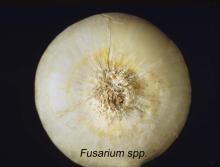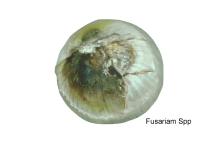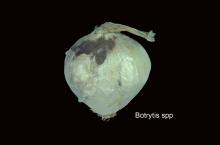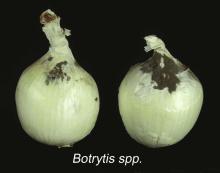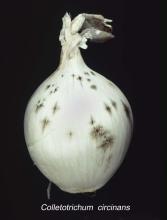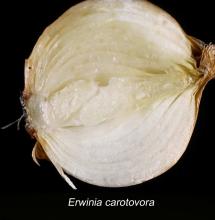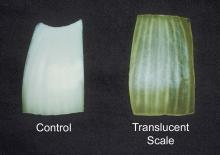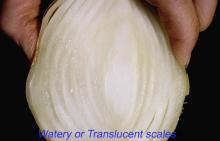Product Description
Indices de Maturité
- Indicated when approximately 10 to 20 percent of tops have fallen over
- Conversion from active growth to dormancy accelerated by undercutting bulbs 1 to 2 inches
- "Field-dry" maturity is indicated when bulb neck is completely dry to the touch and not slippery. Typically reached at 5-8% weight loss following harvest
- Mature neck and scales
- Firmness
- Diameter (Bulb size)
- Absence of decay, insect damage, sunscald, greening, sprouting, freezing injury, bruising, and other defects
- Degree of pungency
Manipulation et stockage post-récolte
Curing
Field curing when temperatures are at least 24°C (75°F) or exposure for 12 hrs to 30 to 45°C (86 to 113°F) for forced air-curing
Storage
Mild onions: Typically 0.5 to 1 month at 0°C (32°F)
Pungent Onions: Typically up to 6 to 9 months at 0°C (32°F) depending on the cultivar
Curing
75 to 80% for best scale color development
Storage
65 to 70% with adequate air circulation (1m3/min/m3 of onion)
Whole Onions
3-4 ml/kg·hr at 0-5°C (32-41°F); 27-29 ml/kg·hr at 25-27°C (75-79°F). Storage between 5-25°C (41-75°F) favors sprouting and is not recommended for extended periods.
Diced Onions
40-60 ml/kg·hr at 0-5°C (32-41°F).
To calculate heat production multiply ml CO2/kg·hr by 440 to get BTU/ton/day or by 122 to get kcal/metric ton/day.
Whole Onions
Diced Onions
NA
Ethylene may encourage sprouting and growth of decay-causing fungi.
No commercial benefit has been identified for varieties with long storage potential. Onions are damaged by <1% O2 and 10% CO2. There is some commercial use of CA (3% O2 and 5-7% CO2) for sweet onion varieties (short storage potential). Diced onions benefit from CA conditions of 1.5% O2 and 10% CO2.
Physiological and Physical Disorders
Freezing Injury. Soft water-soaked scales rapidly decay from subsequent microbial growth
Translucent Scales. Resembles freezing injury and is prevented by prompt cold storage following curing; 3-4 week delay in cold storage increases risk significantly.
Greening. Exposure to light following curing causes green-coloration of outer scales.
Ammonia Injury. Brown-black blotches result from ammonia gas leakage during storage.
Désordres
Botrytis Neck Rot. Watery-decay initiates at neck area and moves downward through entire bulb. Light gray to gray fungal growth is generally visible at neck infection and on outer scales. Proper drying and curing of onion essentially prevents this storage disorder. Storage conditions (as above) should be maintained to prevent condensation from forming on the bulbs.
Black Mold. Black discoloration and shriveling at neck and on outer scales caused by the fungus Aspergillus niger. Often associated with bruising and leads to bacterial soft rot. Low temperature storage will delay growth of fungus following field or handling infestation but growth will resume above 15°C (59°F).
Blue Mold. Watery soft rot of neck and outer scales followed by the appearance of green-blue mold (occasionally yellow-green) spores of the fungus Penicillium. Minimize bruising and other mechanical injuries, sunscald, and freezing injury.
Bacterial Rots/Soft Rot. Water-soaked, foul-smelling, viscous liquidy rot caused by Erwinia carotovora subsp. carotovora.
Slippery Skin. Generally visible only at neck area and upon cutting to expose inner scales. Scales have a watery-cooked appearance.
Sour Skin. Slimy, yellow-brown decay generally limited to inner scales which give off a sour odor when exposed.
General Bacterial Rot Control:
- Harvest only at full maturity
- Proper drying and curing
- Minimizing bruising and scraping
- Maintaining proper storage conditions (as above) to prevent condensation from forming on the bulbs
Special Considerations
Onions are both storage-odor sources for other commodities, such as apples, celery and pears, and storage-odor absorbers from commodities such as apples.
References
References from scientifically validated sources will be added in the future.



